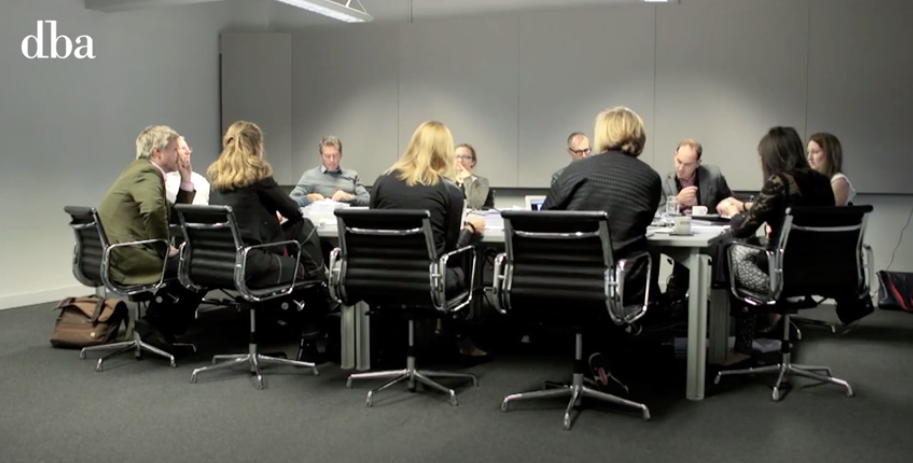Main Content

DBA Design Effectiveness Award winners – here’s how they’re chosen
If you’ve ever wondered how the judges determine the DBA Design Effectiveness Award winners, read on.
Below we explore what happens at the judging sessions and share tips on preparing winning entries.
 “The DBA Design Effectiveness Awards judging sessions are some of my favourite days of the year,” says Chairman of the Judges Clive Grinyer. The judging sessions take place across three stages with the DBA bringing together “a stellar array of professional leaders, visionaries and experienced consumers of design talent,” whose job it is to “share their expertise to validate the evidence in the entry submissions,” adds Grinyer.
“The DBA Design Effectiveness Awards judging sessions are some of my favourite days of the year,” says Chairman of the Judges Clive Grinyer. The judging sessions take place across three stages with the DBA bringing together “a stellar array of professional leaders, visionaries and experienced consumers of design talent,” whose job it is to “share their expertise to validate the evidence in the entry submissions,” adds Grinyer.
Drawn together from an array of sectors, each judge brings unique and critical insight into measuring the strength of the entries on the merits of the case it makes for design effectiveness.
The awards show the impact of design in an unarguable and measurable way. Throughout the process, judges won’t be looking at standards of aesthetics, or ‘good’ and ‘bad’ design but at effectiveness measured in terms of commercial benefits for the client and the customer. Understanding what the judges are looking for will help you create a case study which will steal the show.
At the first stage of judging, judges determine which entries will make it through to stage two, selecting the entries that make a case for design effectiveness against their stated business objectives.
“Be clear of your original objective(s) and make sure it’s believable. Judges know markets,” says Grinyer, “and the measurement of success is all about how design has excelled in reaching and surpassing your objective.”
During the second stage of judging, the strength of the entry and the significance of the results achieved by design are assessed by the panel. Again, entries are judged entirely on their own merits and are not compared to any other entry. It is fundamental for entries to contextualise their results within their wider commercial context in order for the judges to understand the scale of impact achieved by design and reward this appropriately with a Bronze, Silver or Gold award.
You can only win an award if the data clearly shows the impact has been achieved, and by how much. Grinyer is clear that “it’s about the numbers.” Keep the data clear and make sure you show the numbers that are relevant. “Try not to show convoluted segments of data to enhance the results that don’t reflect the true story; we are expert in spotting this,” he says.
The third stage of judging specifically considers the Grand Prix winner. The third panel of judges are all chief executives of highly successful companies. They select the winner of the Grand Prix from amongst the Gold awards and previous judges include Ivan Menezes – CEO at Diageo, Laura Citron – CEO at London & Partners, Ewan Venters – former CEO at Fortnum & Mason and Deborah Meaden – Businesswoman and Entrepreneur at Meadenspeak. The 2022 judging panel will be announced soon.
The DBA Design Effectiveness Awards are about rewarding the impact of design in whatever way it has made a difference. The entry process has been honed over 30 years of successfully running the competition. “It helps applicants tell their stories and bring their evidence so the judges can investigate and reward success across the wide range of case studies,” highlights Grinyer. “Every year the range of entries embraces wider areas from digital, service, innovation and technology. If you have achieved a positive impact from design and can evidence this, you have a very good chance of gaining an award.”
Getting the seal of approval from our expert judging panel provides independent and authoritative recognition of the value of your work. Take a look at what you do and then tell us how what you have done has been transformed by design. “Show the evidence and tell the story,” says Grinyer, “what was the moment of research that unlocked the route to behaviour change or market success? What did design specifically bring that transformed your idea?”
Past judges share their experiences of judging the awards in these short videos:
Previous judges Jo Marshall, Executive Director, YPO, Phil Gowland, Commercial Director, Whitworths and Paul Fraser, Managing Director, 3V Natural Foods share the rigour surrounding the process below:
Businesswoman and entrepreneur Deborah Meaden, shares her experience judging the DBA Design Effectiveness Awards Grand Prix:
Read more from Clive Grinyer here: Reaping the Rewards: Insights into the 2021 DBA Design Effectiveness Award winners
About Clive Grinyer
Clive is an acknowledged expert in design thinking, digital and technology innovation and customer experience and has led digital and innovation projects for business, public sector and government organisations.
He pioneered service design at Barclays Bank and has worked for some of the world’s most creative companies including Apple, Samsung and Cisco. He is Head of Service Design at the Royal College of Art and Chairman of the DBA Design Effectiveness Awards judging panel.
Effective design in business | DBA webinar recording
How do transformative design projects begin? What is the reality of making a case for investment in design and how can design teams support those they are seeking to influence in making that decision?
From the end-to-end design of life saving apps delivering savings to the NHS. Or the transformation of the entire customer experience of high street banks. Design drives efficiencies through its integration at every level of an organisation, from customer experience to product design, brand transformation to innovative service offers – design can, and does, deliver.
Watch this open and honest conversation with two DBA Design Effectiveness Awards judges led by DBA Chief Executive, Deborah Dawton. Cheryl Calverley, CEO at Eve Sleep, and Olivia Salisbury, Group VP of Digital at T. Rowe Price shared their fascinating and unique insights on design effectiveness in their industries.
We explored what design means in business, how success is defined, measured, and isolated in complex environments and how design teams can support and influence clients and stakeholders as they incorporate design in the mix and use it as one of the key drivers for change. How do you tailor your approach to different industries, speak their language and demonstrate the impact your design can have?
Watch the full recording here.